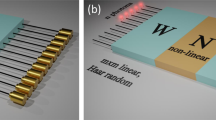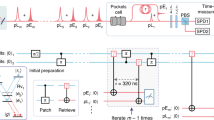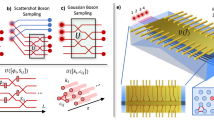Abstract
Boson sampling is considered as a strong candidate to demonstrate ‘quantum computational supremacy’ over classical computers. However, previous proof-of-principle experiments suffered from small photon number and low sampling rates owing to the inefficiencies of the single-photon sources and multiport optical interferometers. Here, we develop two central components for high-performance boson sampling: robust multiphoton interferometers with 99% transmission rate and actively demultiplexed single-photon sources based on a quantum dot–micropillar with simultaneously high efficiency, purity and indistinguishability. We implement and validate three-, four- and five-photon boson sampling, and achieve sampling rates of 4.96 kHz, 151 Hz and 4 Hz, respectively, which are over 24,000 times faster than previous experiments. Our architecture can be scaled up for a larger number of photons and with higher sampling rates to compete with classical computers, and might provide experimental evidence against the extended Church–Turing thesis.
This is a preview of subscription content, access via your institution
Access options
Access Nature and 54 other Nature Portfolio journals
Get Nature+, our best-value online-access subscription
$29.99 / 30 days
cancel any time
Subscribe to this journal
Receive 12 print issues and online access
$209.00 per year
only $17.42 per issue
Buy this article
- Purchase on Springer Link
- Instant access to full article PDF
Prices may be subject to local taxes which are calculated during checkout




Similar content being viewed by others
References
Ladd, T. D. et al. Quantum computers. Nature 464, 45–53 (2010).
Pan, J.-W. et al. Multiphoton entanglement and interferometry. Rev. Mod. Phys. 84, 777–838 (2012).
Barends, R. et al. Superconducting quantum circuits at the surface code threshold for fault tolerance. Nature 508, 500–503 (2014).
Monz, T. et al. Realization of a scalable Shor algorithm. Science 351, 1068–1070 (2016).
Aaronson, S. & Arkhipov, A. The computational complexity of linear optics. In Proc. 43rd Annual ACM Symp. Theory of Computing 333–342 (ACM, 2011).
Kok, P. et al. Linear optical quantum computing with photonic qubits. Rev. Mod. Phys. 79, 135–174 (2007).
Rohde, P. R. & Ralph, T. C. Error tolerance of boson-sampling model for linear optical quantum computing. Phys. Rev. A 85, 022332 (2012).
Wu, J.-J. et al. Computing permanents for boson sampling on Tianhe-2 supercomputer. Preprint at https://arxiv.org/abs/1606.05836 (2016).
Broome, M. A. et al. Photonic boson sampling in a tunable circuit. Science 339, 794–798 (2013).
Spring, J. B. et al. Boson sampling on a photonic chip. Science 339, 798–801 (2013).
Tillmann, M. et al. Experimental boson sampling. Nat. Photon. 7, 540–544 (2013).
Crespi, A. et al. Integrated multimode interferometers with arbitrary designs for photonic boson sampling. Nat. Photon. 7, 545–549 (2013).
Carolan, J . et al. Universal linear optics. Science 349, 711–716 (2015).
Bentivegna, M . et al. Experimental scattershot boson sampling. Sci. Adv. 1, e1400255 (2015).
Carolan, J. et al. On the experimental verification of quantum complexity in linear optics. Nat. Photon. 8, 621–626 (2014).
Spagnolo, N. et al. Experimental validation of photonic boson sampling. Nat. Photon. 8, 615–620 (2014).
Loredo, J. C. et al. Boson sampling with single photon Fock states from a bright solid-state source. Preprint at https://arxiv.org/abs/1603.00054 (2016).
Kwiat, P. G. et al. New high-intensity source of polarization-entangled photon pairs. Phys. Rev. Lett. 75, 4337–4341 (1995).
Pittman, T., Jacobs, B. & Franson, J. Single photons on pseudodemand from stored parametric down-conversion. Phys. Rev. A 66, 042303 (2002).
Kaneda, F. et al. Time-multiplexed heralded single-photon source. Optica 2, 1010–1013 (2015).
Lund, A. P. et al. Boson sampling from a Gaussian state. Phys. Rev. Lett. 113, 100502 (2014).
Lounis, B. & Orrit, M. Single photon sources. Rep. Prog. Phys. 68, 1129–1179 (2005).
Michler, P. et al. A quantum dot single-photon turnstile device. Science 290, 2282–2285 (2000).
Santori, C., Fattal, D., Vučković, J., Solomon, G. S. & Yamamoto, Y. Indistinguishable photons from a single photon device. Nature 419, 594–597 (2002).
Tillmann, M. et al. Generalized multiphoton quantum interference. Phys. Rev. X 5, 041015 (2015).
Shchesnovich, V. S. Partial indistinguishability theory of multiphoton experiments in multiport devices. Phys. Rev. A 91, 013844 (2015).
Tichy, M. C. Sampling of partially distinguishable bosons and the relation to multidimensional permanent. Phys. Rev. A 91, 022316 (2015).
He, Y.-M. et al. On-demand semiconductor single-photon source with near-unity indistinguishability. Nat. Nanotech. 8, 213–217 (2013).
Ding, X. et al. On-demand single photons with high extraction efficiency and near-unity indistinguishability from a resonantly driven quantum dot in a micropillar. Phys. Rev. Lett. 116, 020401 (2016).
Somaschi, N. et al. Near-optimal single-photon sources in the solid state. Nat. Photon. 10, 340–345 (2016).
Wang, H. et al. Near-transform-limited single photons from an efficient solid-state quantum emitter. Phys. Rev. Lett. 116, 213601 (2016).
Patel, R. B. et al. Two-photon interference of the emission from electrically tunable remote quantum dots. Nat. Photon. 4, 632–635 (2010).
Clements, W. R., Humphreys, P. C., Metcalf, B. J., Kolthammer, W. S. & Walmsley, I. A. An optimal design for universal quantum multiport interferometers. Preprint at https://arxiv.org/abs/1603.08788 (2016).
Aaronson, S. & Arkhipov, A. Boson sampling is far from uniform. Quant. Inf. Comp. 14, 1383–1432 (2014).
Bentivegna, M. et al. Bayesian approach to boson sampling validation. Int. J. Quant. Inf. 12, 1560028 (2014).
Cover, T. M. & Thomas, J. A. Elements of Information Theory (John Wiley & Sons, 2006).
Lita, A. E., Miller, A. J. & Nam, S. W. Counting near-infrared single-photons with 95% efficiency. Opt. Express 16, 3032–3040 (2008).
Zadeh, I. E. et al. Single-photon detectors combining near unity efficiency, ultra-high detection-rates, and ultra-high time resolution. Preprint at https://arxiv.org/abs/1611.02726 (2016).
Unsleber, S. et al. Highly indistinguishable on-demand resonance fluorescence photons from a deterministic quantum dot micropillar device with 74% extraction efficiency. Opt. Express 24, 8539–8546 (2016).
Muller, A. et al. Resonant fluorescence from a coherent driven semiconductor quantum dot in a cavity. Phys. Rev. Lett. 99, 187402 (2007).
Acknowledgements
We thank S. Aaronson, B. Sanders and P. Rohde for helpful discussions. This work was supported by the National Natural Science Foundation of China, the Chinese Academy of Sciences, the National Fundamental Research Program and the State of Bavaria.
Author information
Authors and Affiliations
Contributions
C.-Y.L. and J.-W.P. conceived and designed the experiment, C.S., M.K. and S.H. grew and fabricated the quantum dot samples. H.W., Y.H., Y.-H.L., Z.-E.S., B.L., H.-L.H., X.D., M.-C.C., C.L., J.Q., J.-P.L., Y.-M.H., C.S., M.K., C.-Z.P., S.H. and C.-Y.L. performed the experiment, S.H., C.-Y. L. and J.-W.P. analysed the experimental data. C.-Y.L. and J.-W.P. wrote the paper.
Corresponding authors
Ethics declarations
Competing interests
The authors declare no competing financial interests.
Supplementary information
Supplementary information
Supplementary information (PDF 997 kb)
Rights and permissions
About this article
Cite this article
Wang, H., He, Y., Li, YH. et al. High-efficiency multiphoton boson sampling. Nature Photon 11, 361–365 (2017). https://doi.org/10.1038/nphoton.2017.63
Received:
Accepted:
Published:
Issue Date:
DOI: https://doi.org/10.1038/nphoton.2017.63
This article is cited by
-
Efficiently simulating the work distribution of multiple identical bosons with boson sampling
Frontiers of Physics (2024)
-
Efficient representation of bit-planes for quantum image processing
Multimedia Tools and Applications (2024)
-
Single-photon detection using high-temperature superconductors
Nature Nanotechnology (2023)
-
Experimental simulation of loop quantum gravity on a photonic chip
npj Quantum Information (2023)
-
Recent progress in quantum photonic chips for quantum communication and internet
Light: Science & Applications (2023)



